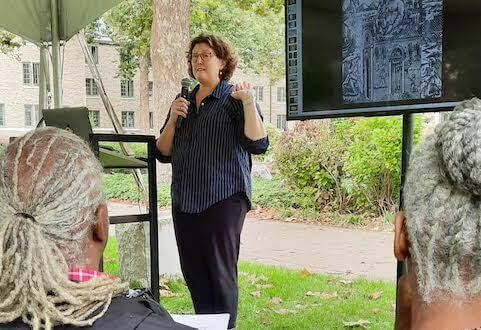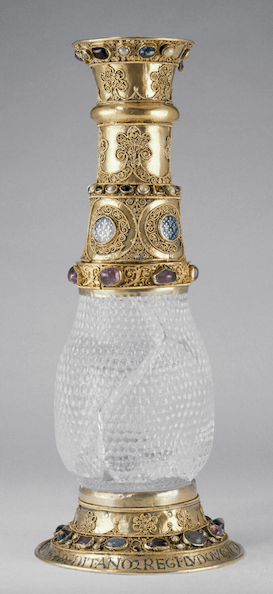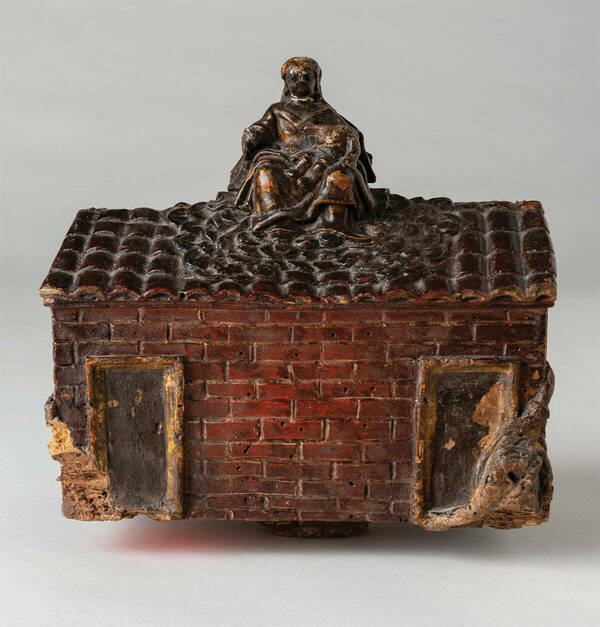
As part of its 75th anniversary celebrations, the Medieval Institute hosted a set of short talks by Notre Dame faculty about important objects from the medieval period before the home game against Cincinnati on Saturday, October 2nd. Despite the rain showers, the talks attracted a great crowd!
Several medieval manuscripts made an appearance. Director of the Institute Professor Thomas Burman presented on a medieval Book of Psalms. Professor Ann Astell (Theology) discussed Hildegard of Bingen's Prayer Book, ca. 1180 and owned by the Bavarian State Library. A complete facsimile of the prayerbook can be consulted in Notre Dame's Rare Books and Special Collections.

Curator David T. Gura (Hesburgh Libraries) spoke about the Ferrell Bible (Notre Dame, Hesburgh Library, Ferrell MS 1), a historiated Bible produced in Paris ca. 1240 and a gift to the University of Notre Dame from James E. and Elizabeth J. Ferrell. The Bible is on display during Fall 2021 in Rare Books and Special Collections and via a digital exhibition.
Other objects included the Coronation Mantle of the Holy Roman Empire, a luxurious gem-strewn coronation robe made by Arab artists ca. 1135 for King Roger II of Sicily and presented on by Professor Christopher Liebtag Miller (Medieval Institute).
The Medieval Institute's current Mellon Fellow, Professor Mohamad Ballan, discussed the importance of the late antique or early medieval Eleanor Vase, made of rare rock-crystal and decorated with gilded silver and precious stones and held now at the Louvre.
The complex political and social relations between Muslim and Christian elites along the frontier in the Mediterranean world vacillated between conflict and collaboration, and luxury objects such as the Eleanor vase were used in negotiating those relationships.
The vase's origins remain something of a mystery, though more its known about its journey: it can be traced to Fatimid Egypt (10th–11th centuries A.D., although there are debates about whether it originated there or in the ancient world) before arriving in Spain during the mid-late 11th century. Its arrival in Islamic Spain reflects the commercial and diplomatic networks which connected Egypt and al-Andalus during the 11th century. The kings of the Banu Hud of Zaragoza (northern Spain) acquired the vase, and it became an important part of their treasury.
It was actually the last of these kings, 'Imad al-Dawlah ibn Hud (the Mitadolus mentioned on the vase), who gifted it to William IX, Eleanor of Aquitaine's grandfather, as part of a larger alliance directed against the Almoravid empire. Eleanor gave it as a wedding gift to Louis VII of France, who then gave it to Abbot Suger (d. 1151) of St. Denis.
Suger then donated the vase "to the saints" and was responsible for the inscription around the base that tells this wonderful story: “as a bride, Eleanor [of Aquitaine] gave this vase to King Louis [VII], Mitadolus [‘Imād al-Dawlah] to her grandfather, the King to me [Suger], and Suger to the Saints” (the Latin reads, "hoc vas sponsa dedit Aanor regi Ludovico; Mitadolus avo, mihi rex; Sanctisque Sugerus").

Professor Margaret Meserve (History) spoke about a late-medieval model of the Holy House of Loreto (ca. 1490), associated with medieval Italian devotion to Our Lady of Loreto.
The small, carved wooden house is a confraternity symbol and would have been used processionally on a staff. The house was gifted to the Medieval Institute by Gephard R. Durenberger ('58), and you can view it on the seventh floor of the Hesburgh Library, just outside of the Institute main reading room doors, in our display case.
Many thanks to all our presenters for the opportunity to learn more about these fascinating objects!
Read more about our planned events celebrating the Medieval Institute's 75th Anniversary, which include medieval-themed presentations before every home game this fall.
Originally published by at medieval.nd.edu on October 13, 2021.